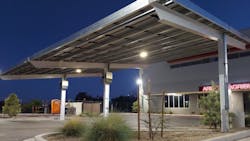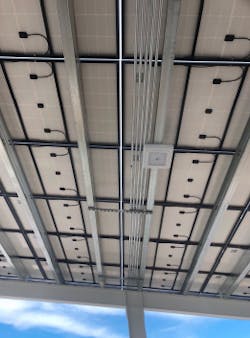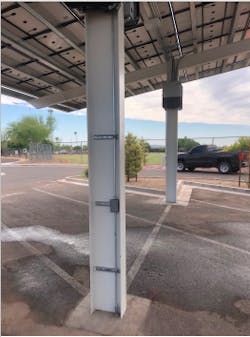SRP Completes 31.2kW DC Solar Project Benefiting Mesa Arizona High School
Salt River Project (SRP) is a community-based, not-for-profit public power utility and the largest public provider of electricity in the greater Phoenix metropolitan area. Greatly invested in the area’s future, SRP is committed to lowering carbon emissions and building a sustainable future for the customers and communities it serves. In 2007, SRP established its “Solar for Nonprofits” to help promote sustainability in Arizona and provide customers a way to help support nonprofit organizations providing vital community services.
Since its inception, SRP’s Solar for Nonprofits program has successfully donated and installed 49 solar power systems at local nonprofits. The latest solar system installation through this program became operational in July of 2021 at the Arizona Agribusiness & Equine Center High School (AAEC) in Mesa, Arizona. The mission of AAEC is to prepare young adults for excellence in academics, social responsibility and lifelong learning, and school administrators say they have many students at AAEC interested in pursuing sustainability-related college degrees and career paths. This attributed to why AAEC submitted for the chance to receive a solar system through the SRP Solar for Nonprofits program.
The solar system was awarded to AAEC as part of SRP’s previous call for applications for its Solar for Nonprofits program in which three nonprofits were awarded systems that were recently installed or are soon to be installed.
The solar system at AAEC High School was installed on top of a newly constructed parking structure, or “solar canopy,” which was also provided by the SRP Solar for Nonprofit program. The system will produce approximately 54,193 kWh annually to help offset the school’s energy costs and reduce the school’s carbon emissions.
Design and Construction
SRP awarded the bid for the electrical and structural design of the AAEC High School solar system to one of its Preferred Solar Installers, Harmon Electric who navigated the permitting and interconnection process. SRP ensures each solar facility meets its safety standards and interconnection requirements. Systems are sized for optimal load offset in accordance with current price plans. Safety standards ensure these systems can also be isolated from the power system when maintenance is required. This means the solar system can be taken offline without impacting the rest of the surrounding electric grid.
Construction and installation of a solar system the size of the one at AAEC High School in Mesa, a little over 30kW, typically takes between four to six weeks. This particular project took about a month once construction started and began with drilling caissons, setting steel columns, and pouring cement for the foundation of the solar canopy which is outfitted with steel beams. These beams were installed and then inspected by the engineer of record, then painted the color requested by the customer.
Once the beams passed inspection, contractors with Harmon Electric installed purlins to the steel structure that sit on top of the canopy. From here, the solar modules were installed and anchored to the purlins using nuts and bolts. Then, four inverters were installed and mounted on the steel columns which each control a set of three strings with 12 solar modules grouped together and connected to the inverters.
After the inverters were wired to modules, they were aggregated on an AC recombiner which is also installed on the steel canopy. The AC combiner box has circuit breakers for the inverters which are combined inside the box. Wires from the box are then run underground in PVC conduit connecting to the PV Meter Socket, then to the disconnect (“safety”) switch and finally at the customer’s service section located in the electrical yard approximately 100 feet from the solar canopy.
At the system’s commissioning, SRP observed as Harmon Electric turned on all four system inverters to ensure they were running properly. During the commissioning Harmon Electric also tested the system’s safety switch. When a safety switch works properly, the entire system shuts down preventing any flow of electricity from the system.
In the instance of the AAEC High School in Mesa everything was done according to plan, and the system was commissioned with all inverters working properly as well as the safety switch.
Improved Installation Over Time
As SRP continues to develop these systems for local nonprofits and work regularly with qualified contractors to design and install these projects, construction continues to go smoothly from start to finish.
The teams have learned how to conduct project work in the proper sequence to ensure efficiency, with great collaboration between SRP’s engineering team and the contracted electrical engineering team. The teams agree safety is of the utmost importance and continually work together to build safe operating systems to ensure compliance with current electrical codes. Installation standards such as wire management and equipment mounting continue to evolve and improve, which only helps the installation process run more fluently and according to schedule.
The Solar for Nonprofits program is funded by SRP customers who contribute as little as US$3 a month to the SRP Solar for Nonprofits program. Collectively, the program has helped nonprofits save nearly US$1 million while providing renewable, emission-free energy for their buildings.
To qualify, nonprofit applicants must be designated 501(c)(3) organizations, have their headquarters based within SRP’s electric service territory and have a parking structure or a parking lot to which SRP can add a donated structure. Additional eligibility requirements and information about the program can be found here.
For the AAEC high school in Mesa, having this solar structure onsite powering a portion of this facility’s operations demonstrates to the school’s students firsthand how solar energy can offset carbon emissions and energy costs. It also creates more community awareness around renewable energy and carbon reductions. Another phenomenal benefit is the shade it provides to organization’s parking lot which is invaluable on hot Arizona summer days.
About the Author
Kathleen Munroe
Kathleen Munroe joined SRP’s Distributed Energy Programs (“DEP”) as its manager in December 2019 and has been with SRP 11 years. In addition to overseeing SRP’s customer supported environmental programs, the department’s primary objective is to enable the interconnection of customer-sited generation. Before joining SRP’s DEP, Kathleen was a principal contract analyst negotiating Large Generator Interconnection Agreements and participant agreements for high-voltage transmission projects. Prior to this, Kathleen was a principal resource analyst in SRP’s Resource Planning and Acquisitions where she oversaw the closings on utility scale solar and natural gas generation acquisitions.




